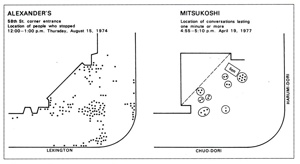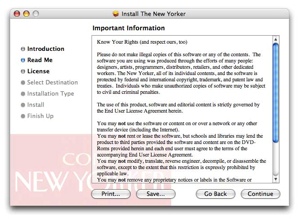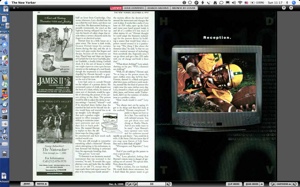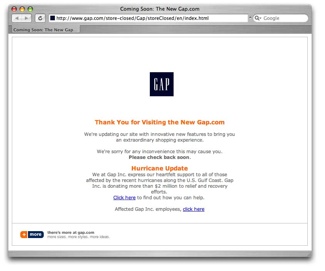
|
|||||||||||||||||||||||||||
|
Sunday 30 October 2005
Customer Service
Anatomy of a Customer Service Failure I recently left my phone charger at the Hotel Los Gatos, in Los Gatos, California. I forget things in hotels all the time — probably because I wind up having to use every last electrical outlet in the room, most of which are behind furniture — so I’m used to the procedure: you call them up, describe what you’ve left behind, and then wait for a call back from the hotel. I have never actually lost anything this way, probably because hotels have to be on the lookout anyway against staff pinching guests’ valuables. If you’re the kind of person who’s likely to steal cheap things left behind by guests, I’d assume you’re more trouble than you’re worth and you don’t last long in the hospitality business. Anyway, so we called them and described the thing, and they called back saying they’d found it. We told them to ship it back to us ground service, no priority, etc. We have had the experience in the past, more than once, of something that costs $10 being sent back to us via the double-express, overnight, Federal-Express-waking-you-up, very expensive service, and we wanted to head this off. The Hotel Los Gatos complied, I suppose, as best they could, and they sent it to us as a FedEx Express Saver letter.
However. Los Gatos is in California, and Tino Manor is in Virginia, 2362 miles away in a straight line. This means that from Los Gatos, Tino Manor is in ‘Zone 8’ for FedEx rate calculation purposes — ‘Zone 8’ being as expensive as things get in the United States: there is no ‘Zone 9’ (though there are a whole raft of surcharges for shipments to Alaska or Hawaii). So a FedEx Express Saver envelope from Los Gatos to Front Royal costs $10.05. There is, strictly speaking, no Express Saver envelope rate: the FedEx envelope just gets charged the one-pound rate. There’s then a fuel surcharge of 15.5%, or about $1.55. Then, since Tino Manor is a residence, and since FedEx hates delivering to residences because it takes them longer, there’s an additional $2.00 charge for that. Then, because while Tino Manor is not quite in the middle of nowhere, but still not in the city or the suburbs, there’s an additional $2.00 surcharge. Then, if the hotel had FedEx pick up the package rather than dropping it in a box or handing it over to them on a regular stop, there’s an additional $4.00 charge. I have no way of knowing what they did here. All together, shipping this $10 charger from California to Virginia via FedEx cost between $16 and $20. We won’t know for sure until FedEx gets around to charging the credit card. (See UPDATE below.) The customer service failure here? There are two or three of them. The most serious failure is FedEx’s. It’s difficult to determine in advance just what a FedEx shipment is going to cost. Three or four surcharges applied to this shipment; if all four of them were applied, the surcharges nearly doubled the price. I can understand the logic of applying ‘fuel surcharges’ rather than changing your base price every month, but when the surcharges start to get close to 100% of the base price, these aren’t surcharges so much as the ‘base’ price is a lowball price. FedEx is in possession of a quite valuable brand, though, and they exploit it to stay in business while providing what is frankly crap service; I tend to avoid FedEx whenever I have a chance, because that $2 surcharge for boonies delivery — we are all of 50 miles from Dulles Airport — typically comes with a day or two of delay as well. And don’t get me started on ‘FedEx Ground’; I’m lucky if that stuff shows up at all. The other customer service failure is on the head of the Hotel Los Gatos. I have no doubt that they do all of their shipping via FedEx; if you sign a blanket deal, you get a discount — though the cost is still hidden from the employee holding an envelope in his hand and trying to decide what it’s worth to ship it. When they ship a lost-and-found item to a customer, they tell FedEx to bill it to the customer’s credit card, though, and so no discounts apply. As a result, the best they appear to be able to do for this kind of shipping is absurdly expensive. If they’re paying anything like these rates themselves, it leads to the Hotel Los Gatos growing more expensive or possibly losing money, which would be a shame because it’s quite a nice place and is recommended by Tino. The U.S. Postal Service will ship an 8-ounce package overnight, with tracking and delivery confirmation, between almost any two addresses in the United States for $13.65. If you are in less of a hurry and need it there in three days (à la FedEx Express Saver), it’s $3.85 via Priority Mail. If you are even more casual and sure of the weight, you can send it via First Class Mail for $1.85 (First Class Mail is essentially the same service as Priority Mail but with different marketing). So the markup, essentially, on the FedEx shipment over the USPS shipment, is anywhere from 146% to about 2000%: that’s higher than the hotel’s markup on room-service booze, and in the case of the shipping charges, the hotel is not itself getting any of that money. Why do they do this? Why on Earth doesn’t the hotel charge a flat rate of $15 to return small lost items and then ship them Priority Mail or Express Mail and thus make a profit? The Hotel Los Gatos is the kind of place where you have to tip someone to get a bucket of ice (see more on this here), so I know they’re well attuned to the many and varied opportunities for wringing small sums out of their guests. My theory is that while FedEx is widely seen as one of the engines of America’s productivity revolution, and while they are regularly touted as an example of industrial efficiency, they are in fact a huge efficiency sink. FedEx and its competitors do business largely by encouraging companies to sign corporate-wide shipping contracts at negotiated rates. Individual departments — the people who actually ship things — then have little or no visibility into, or say about, how things are to be shipped. (I have even seen some companies where departments that shipped things had their budgets charged internally for the full retail cost of the shipping — in an attempt to turn the mail room into a profit center for the company. These companies have all since gone out of business, since that kind of voodoo accounting doesn’t produce actual revenue.) As a result, the vast majority of the shipping companies’ poor service and high prices are not subject to the normal checks of the market, and people like FedEx and UPS can stay in business. UPDATE 2 November 2005: Quoth Amex: $19.61. So the ‘surcharges’ amount to 95% of the ‘base’ price. Posted by tino at 13:53 30.10.05
Thursday 27 October 2005
Random Interesting Thing
Finally! A Washington Post headline:
Robots May Allow Surgery In Space. It’s a good start that the robots are at least considering allowing surgery in space, but I’d also like to see them considering other important issues like stem cell research and underwater hairdressing. How did humanity sink so low? It used to be that we were in charge of the robots. I have to go now: the Roomba wants a massage. Posted by tino at 09:23 27.10.05
Saturday 22 October 2005
Random Interesting Thing
Accidental Community So I am sitting here in a bar at the Oakland airport, sharing my Verizon EVDO connection to all and sundry so they don’t have to pay the absurd $10 for the airport’s own Wi-Fi service. And someone sent me this picture, using, I think, the Bluetooth file-transfer utility:
Which was nice. Posted by tino at 23:33 22.10.05
Tuesday 11 October 2005
Urban Planning
Central Planning In Maryland
That’s Montgomery County (MD) council member Nancy Floreen, quoted in a Washington Post story about a new proposal to do something about Montgomery County’s lack of ‘affordable housing’. Montgomery County is a victim of its own success, Ms. Floreen says. That’s an interesting way to look at it. To begin to understand the problem, please consider this map. Clicking on it will pop up a (much) bigger version:  This is a map of all the properties listed in the Washington, DC multiple listing service on August 20, 2005, plotted by location and colored by price. The colors run, from least to most expensive: blue, green, light yellow, dark yellow, orange, red, purple. The exact values vary from map to map, but on this one, they are:
Montgomery County, Maryland is outlined in black. The county actually extends pretty far north, off the map; about 60% of it is shown here. But even seeing only this part of the county, it’s clear what’s going on: Montgomery County is not so much the ‘victim of its own success’ as it is the victim of the fact that it’s illegal to build anything in half the county. Half the county is protected farmland, through which it’s impossible to build a badly-needed road. The lack of a road and bridge connecting the outlying Virginia suburbs (and Dulles Airport) to northern Montgomery County limits where you can effectively commute from if you work in the county; that demand, and the fact that nothing can be built in half the county, push up real estate prices. If your goal is to inflate the price of your real estate, I heartily suggest that you hire Montgomery County planners as consultants. They have done a very good job. But the constant complaining out of Montgomery County seems to suggest that their actual goal isn’t to inflate real estate prices. At the moment, the crisis seems to be that police officers, firefighters, and teachers — of which Montgomery County has many — can’t afford to live there.
Silverman is expected to run for county executive in 2006.
Housing projects. For the middle class. This is what it’s come to, in Montgomery County. I cannot help but notice that middle-class people (in this case, people making up to $100,000 a year, so genuinely middle-class) in the United States generally have no problems finding and buying the things they need on the open market. Cars, clothing, food, globe-trotting vacations: quite a large fraction of the world’s industrial output is dedicated to meeting the needs of middle-class Americans. But they can’t afford to live in Montgomery County, Maryland, because the county has variously restricted where you can build; what you can build; how you can build; and who you can sell to. New residential construction in the county has to have sprinklers throughout; new developments have to have 12.5% of their units set aside for the county’s existing affordable-housing program; and at the moment, you are not allowed to start any new construction in the county thanks to a permit moratorium enacted this summer. In Chevy Chase, there’s a separate six-month town moratorium on construction, intended to fight what they call ‘mansionization’. They don’t want mansions in Chevy Chase: they apparently want just what they already have: million-dollar three-bedroom bungalows. This, ladies and gentlemen, is ‘success’, as in ‘being a victim of success’. Because certainly those sprinkler systems, and the costs incurred by builders when they’re hit with unannounced moratoria, and the cost of leaving half the county’s land empty are borne by someone else, and not the hapless would-be Montgomery County resident. So the proposal, to further correct this housing shortage that arises out of the county’s interference, is, of course, more county interference. Already, if you make less than 70% of the median income, you qualify for Montgomery County’s bureaucratic affordable-housing program, where builders are required to build housing that is rented or sold at below-market rates in exchange for being allowed to build anything at all. Now, the proposal is to force builders to subsidize another class of housing, this to be rented or sold at below-market prices to people based partly on their income but also on whether they work for the county. This means that the county can continue to pay these people wages that do not allow them to live in the county, but that the county can nevertheless increase these people’s effective compensation by requiring builders to pay part of the teachers’, firefighters’, and cops’ salaries in the form of subsidized housing. The beauty of this scheme is that the builders will have no choice but to raise prices on the housing that they are allowed to sell at market rates. If — to use an extreme example — the county required builders to give away 20 houses for every 80 they were allowed to sell, those 80 would have to be sold for 120% of the price they’d otherwise sell for. This would price them out of the reach of more people, who would then clamor for someone to subsidize housing for them. Essentially, the county is supporting its housing subsidies through a hidden tax on all unsubsidized housing in the county; this tax, in turn, increases the demand for subsidized housing and thus the power of the county in granting ‘relief’ from the pain that they are themselves inflicting. Who will be next? Which group of people will be the next to be priced out of Montgomery County’s ‘open’-market housing and to petition the county for relief? My money is on retail workers. Posted by tino at 17:35 11.10.05
Customer Service
A Trip To The Mall The Tyson’s Corner Mall, Sunday afternoon. The big news around here — and this will tell you a lot about what Washington is like apart from the earth-shaking affairs-of-state stuff that goes on in the fancy buildings downtown — is that the big addition to the Tyson’s Corner Mall is open. Nicole and I were in the area, so we decided to drop in and see what it was like. We were coming from Maryland on the Beltway, so we entered via the bridge over 123; the idea here is that people coming from the Beltway can then get into the mall via three right turns, rather than a mad dash from the Beltway exit and into the left turn lane. This winds up shooting you straight at the mall’s new parking garage, which would be great except that twenty feet inside the entrance people entering the garage are instructed by a sign to YIELD to people already in there. So when the mall is even a little bit crowded, the signal-controlled intersection just outside the garage winds up gridlocked. And the mall was more than a little bit crowded; it was jammed. It was like the day after Thanksgiving in there. It took us fifteen minutes just to park the car in the garage, because you can’t just zip up to the (largely empty) upper floors and park there. No, to get to the higher floors you have to drive past at least twenty parking spaces (not to mention large roped-off areas reserved for valet parking) on each of the lower floors. This means that you’ve got to wait for people who are leaving to pull out of their spaces, and for the people who are replacing them to jockey their cars around in 23-point turns. Eventually, though, we crept past all of this, parked the car about 40 feet from the bridge to the mall, and went inside. Pandemonium. The place was jammed with people, with all that that entails. In malls, a lot of people walk quite slowly, either because they’re too fat to move any more quickly, or because they’re window shopping. Unfortunately, the trend of cluttering up the mall with all sorts of low-rent pushcarts selling cheap plastic crap means that there’s almost no way to get around these people. The slow-walkers aren’t the real problem though: the dead-stoppers are. These are people — usually in groups of four or five — stop dead in the middle of everything and have a conversation. They were out in force on Sunday. I believe that this is something ingrained in the culture. In the 1970s, William H. Whyte — best known among the general public for writing a book called The Organization Man — did a study of urban crowding in New York, Tokyo, and Manila. One of his methods was to make films of urban spaces and see how people distributed themselves. It turns out that this varies significantly from place to place: (Click for a bigger version) On the left is a diagram of stationary people on the sidewalk outside a New York department store; on the right the sidewalk outside a Tokyo department store. In New York, people have a marked tendency to stop and loiter bang in the middle of the flow; in Tokyo, off to the side. And yet most of the people standing in my way at the Tyson’s Corner Mall this weekend appeared to be Asian and, unless I am mistaken, specifically Japanese. Clearly the melting pot is working. But I digress. We wandered around the mall for a while, looking for a bathroom (which we eventually found, and found jammed with people but totally unjammed with such things as toilet paper or towels) and then for something to eat. One of the big attractions of the mall expansion is the new food court. The Tyson’s Corner Mall did not, previously, really have a food court; it had a little food corridor that really wasn’t up to the task. The new attraction had done its job, all right: it had attracted most of the population for miles around. We eventually concluded that there was absolutely nowhere to sit, and so gave up on the food court. The food court is surrounded, though, by actual (chain) restaurants, whose websites I’m not going to link to because they all involve terrible, useless Flash splash screens. Screw ‘em. The nearest one was TGI Friday’s, so we headed there. There was plenty of seating available there, and the Redskins-Broncos game on TV. There were six employees standing around the entrance when we walked up, so there was some initial confusion about whom to approach for seating. After this sorted itself out, we were told that a table for two would be a thirty to forty-five minute wait. The mall is jammed. The food court is packed. There is a gaggle of Friday’s employees blocking the door, and plenty of empty tables in there. And there’s a wait of three-quarters of an hour for a table because (they said) they were having some kind of staff problem. A shift change, maybe, or not enough people working in the first place. Eventually we wandered down to the Sbarro, in the less-crowded, pre-expansion part of the mall. At Sbarro, it was the usual experience: the food cold before we sat down because paying for it takes forever because the employees move like they’re in a coma; trash all over the place; screaming kids; torn upholstery; paper napkins parceled out one by one by the comatose employees because excess napkin usage must be why they’re not making any money. If you set out to create a more frustrating, less commodious place, I doubt you could do it. I understand that malls are deliberately manipulative places — this is presumably why, for instance, there’s now a quarter-mile stretch of mall with no way to get between floors except for a very slow elevator — built for the purpose of maximizing revenue. I have no problem with this. However, it is a problem that the mall and its tenants seem to be taken entirely by surprise by the fact that crowds of people might, you know, show up there and want to spend money. Untold millions of dollars have been spent to create this temple to retail commerce, and the officiants are unable to perform the rite. Why? Why should I attempt to go back to this place and attempt to do my Christmas shopping? Why should I go back there at all, except to buy something that’s available nowhere else (and nothing they sell there is available nowhere else)? What does this portend for American society and the economy? It might be dangerous to draw conclusions from the Tyson’s Corner Mall, because it’s quite atypical. The famous Capital Beltway, the very emblem of atypicality, lies about 50 feet from the terrible new parking garage. Still, I cannot help but notice that the St. Louis Galleria (which I wind up in a few times a year) has almost precisely the same problems as Tyson’s Corner, despite being hundreds of miles away in the Midwest. It’s overcrowded (by design); it’s hard to park there; it’s hard to get there because it creates its own traffic jams; it’s hard to spend money there, because everything is operating at 110% of its real capacity; and I get a sore throat there after about a half hour because the air is too dry. Famous St. Louisan Yogi Berra once said, of a nightclub or something, ‘Nobody goes there anymore; it’s too crowded.’ Like most of Berra’s famous one-liners, there’s a lot of truth in the statement’s contradiction, and I think there’s a real danger here for the retail industry. I strongly suspect that this is a problem with a sharp tipping point, that the half-assed approach to retail will work up to a certain point (it’s working now, right? My main problem is that the place is too crowded), and then, suddenly, hardly work at all. You won’t see a gradual slackening of demand for malls where shopping is toil, something to which the industry could respond: I think that one weekend the retailers will simply find themselves peering up and down the empty malls, asking, ‘Where’s Poochie?’ You read it here first. Posted by tino at 12:58 11.10.05
Friday 07 October 2005
Media
The Complete New Yorker The Content The first thing you notice about the new New Yorker archive collection, with every issue of the magazine up to February, 2005 on eight DVDs, is that the physical package was designed by an idiot, or a sadist. It’s a folder, nine inches wide by twelve inches high; the DVDs are in a further fold-out section on the right, and a rather nice book on thick paper with ‘highlights’ from the magazine over the years is glued into the folder on the left. If you think about that for a moment, you will understand why I say the designer was an idiot; if you try to read the book without having the whole assembly laid flat on a table, you have to deal with the DVD section— which is twelve inches by twenty-seven inches when unfolded, which it will quickly be if you’re not careful — flapping about. In short, it’s impossible to read the book without a table, or a third hand. If the DVDs had been put on the left, though, and the book on the right, the open cover of the book could have been grasped along with the DVD section by the left hand, while the rest of the book could have been grasped with the right hand, in a way that will be familiar to anyone who has ever read, say, a magazine. This is a small thing, but as the utility of the whole product could have been improved immeasurably at absolutely no cost, it’s nevertheless an annoying thing The second thing you notice about The Complete New Yorker is that in the accompanying book of highlights from the magazine (cf. above), of the book’s one hundred and twenty-two pages, six are devoted to articles about the war in Iraq, and three to the whole of World War II. Or maybe four, if you count a Janet Flanner profile of Hitler in 1936. The New Yorker’s politics haven’t changed — to the extent that it has an editorial outlook at all, it’s always been left-wing, and about as left as it is today. Recently it does seem more bitter about its politics, but this is hardly something that is unique to the magazine. It’s particularly a shame for the New Yorker, though, because its whole style is very much about being supercilious and aloof. The voice of the New Yorker is the voice of someone who is supremely confident that he knows better than everyone else. For a person with that outlook to even appear to be bitter is to be defeated. The Technology The Complete New Yorker comes to you on eight DVDs, packaged in the aforementioned terrible folder/book thing. The marked price is $100, so the fact that the DVDs are housed in a scratchy cardboard sleeve is a bit galling. Overall, the technology of the collection isn’t really bad: by which I mean that it is merely very bad. In the late 1990s, National Geographic put out a 31-CD set with their entire 110-year archive on it. The thing was an unbelievable dog, and effectively unusable. The scans were of such low resolution that you could barely, by squinting mightily, manage to read the text; printouts were totally illegible, and you could not copy and paste from within their proprietary interface. I was worried about some of the same issues coming up with The Complete New Yorker. Nearly all of them are there, but improvements in computer technology have resulted in these things being merely annoying, rather than crippling — as long as you are patient. The biggest problem is the speed. The indexes for authors, articles, etc. are stored in a SQLite database, and the magazines themselves are stored as DjVu files of about 10 MB each. 10 MB for a whole magazine, with the illustrations and photos looking good and even the smallest text readable, is amazing. Despite the fact that the Complete New Yorker uses this fairly open and standard technology, though, you’ve got to use their custom application to read the files. They’re stored in some kind of ‘secure’ DjVu format. And this is a problem, because the application you need to use to read the files is a dog. I timed the thing’s responsiveness on my Mac Mini with a 1.42 GHz G4 processor and 1GB of RAM:
This means that, once you are reading a given issue, you are pretty well committed to that issue. If you are reading the October 4 issue and want to see something in the October 11 issue, you are going to have to go get a cup of coffee while you wait. It could be worse, I suppose. The license statement is unusual: Almost all commercial software licenses are mainly about threatening and insulting the customer. This one doesn’t give you any more rights than any other commercial software license I’ve ever seen, but at least it’s polite about it. What’s less polite is that the installer insists on restarting the computer when it’s done — despite the fact that there isn’t anything installed that would require a restart. After the installation completes, but before you restart, the install DVD can’t be ejected because the system thinks there’s a file open on it. This is probably the whole reason for the restart. When you’re done restarting, the single most annoying thing about the application — even more annoying than the fact that the whole thing uses non-standard UI widgets — is that the window has two sizes: covering your entire screen, or minimized. If you’ve got a screen that’s larger than is needed to display the pages, The New Yorker helpfully takes over the remaining real estate in order to display pleasing gray borders. On my PowerBook, this means that when viewing a full spread, about 20% of the screen is simply wasted. Far worse than that, though, is the search window. The search window is not customizable, not resizable, not able to be modified in any way. The ‘Article Abstract’ pane is always 756 pixels wide and 88 pixels high, no matter how long the abstract is. There is always room for fourteen search results, no less and no more. There are always over 140,000 pixels dedicated to the ‘Sources’ list, whether the user wants to use that list or not. If you want to narrow your search down to a few specific years, departments, or authors, and then dedicate more screen space to the search results themselves, you are out of luck. Similarly, the search results cannot be sorted in any way. Generally they’ll come up in chronological order, but not always. Want them listed in chronological order? Too bad. Oh, yeah, and it crashes a lot, too. And the program officially calls itself ‘toolbars’ for some reason that is entirely beyond me. I suppose I should consider myself lucky I use a Macintosh, and not only for the usual reasons. Under Windows, the hideous and useless ‘Safedisc’ system is used in an attempt to ‘secure’ the discs against copying: because otherwise the teen h/\x0rz would be all over trading 50 GB of smug cartoons and Hammacher Schlemmer ads. A far more effective copy-protection system is embedded in the Windows version of the application itself. As soon as you run it, you see this: If you click ‘continue’, the error message goes away, until you attempt to do anything else. I have not, as of yet, managed to get the Windows version of the program to display any actual New Yorker content at all. This has got to deter copying quite a bit. Maybe people would like to give copies to their enemies, though: I have no idea. Those whom the gods would frustrate, they first make buy software for Windows. Presumably it is possible to get the thing to run on Windows; it’s not really conceivable that they let it out the door without testing at least that much. My guess is that its SQLite engine and my version of the .NET Framework don’t get along. I don’t see why this should be my problem, though. So the software is bad. I don’t know who developed the stuff, and I don’t know what kind of requirements were imposed on the developers. But I do know that there appears to have been a lot of effort put into things that don’t pay off. There are over a hundred little pictures and things embedded in that application, totaling almost 4 MB, that duplicate things that you get for free from the OS if you don’t need your application to look and behave in its own unique way.
On the left you see the Complete New Yorker print button. It’s a 28K TIFF, and someone had to create it for this application. (And they had to create another, slightly different one to be displayed while the button is pressed.) On the right is the standard Macintosh print button, used everywhere else. It was created by professional button designers at Apple, and is present on every Macintosh. You just tell the system to display the print button, and whoomp there it is. The thing is, you don’t want your application to behave differently from all others; the custom UI widgets are worse, not better, than the standard ones. Not only haven’t they had the same amount of attention and thought put into them (Apple can amortize its UI-design expenditures over a far larger number of sales), but the users aren’t used to them. If you use the standard widgets, you get to take advantage of everything the users have learned from using other applications. And what’s more, you get to use your development resources to make things work properly, rather than to tweak the appearance of things. Had the New Yorker been able to tolerate their collection looking like a normal application, rather than a lifestyle accouterment, the lists would have been sortable, the windows resizable, and the whole thing easier to use — and they might have been able to work out at least some of the more debilitating bugs before shipping the product. The information available in the Complete New Yorker is amazing: a history of the last eighty years in the life of the USA, as seen through the lens of snooty bourgeois pop culture. Many of the best writers in America, and in the world, contributed to this document, and even the advertising is interesting beyond all belief. Unfortunately, the system you must use to view this document is terrible, and will be entirely useless far sooner than the collection itself will be. Is it possible to do better? Yes, and very easily. The documents themselves are locked up, though, and thanks to the DMCA it’s a federal crime to reverse-engineer their ‘protection’ schemes for the purpose of getting better access to the information that you paid for. There might be hope for the future. I have read, here and there, that the New Yorker plans to release a new disc each year, so as to keep the collection up-to-date. If they actually do this — I will be surprised — they’ll have a chance each year to update the application, and presumably to make it work better. At $60, it’s still a reasonable buy as it is: the magazines are worth many times that. It’s really a pity about the application, though. I’m sure that, before long, someone will manage to reverse-engineer the content-protection scheme. Once the content isn’t so ‘protected’ from the people who’ve bought it, the collection will become much more valuable. By that time, though, the New Yorker will probably have remaindered half the run at $10, claiming that ‘piracy’ cut into their sales and vowing never to offer anything like this again. Posted by tino at 18:39 7.10.05
Tuesday 04 October 2005
Corporate Idiocy
Sell Your Gap Stock Now The Gap has been struggling for weeks now with a bad re-implementation of its website. The site was down all together for most of the month, and while now it’s ‘up’, that’s being charitable. Imagine you are using an Apple Macintosh computer, and further that you are using Safari, the only web browser that’s shipped with the Mac. What do you think you’re likely to see then? Maybe this foghorn will answer your question: Wah-Waaahhh.
And what if you try to visit the website of Banana Republic, the Gap’s ‘upscale’ store? Wah-Waaahhh.
Both sites — they appear to be run from the same code — do a few pointless redirects, and then continue to reload the same script, forever. This movie shows what happens with the Gap, and this very similar movie shows bananarepublic.com in ‘action’. The sites appear to work fine in Internet Explorer on Windows, and in Firefox on both Windows and the Mac. Still, though: you would think that after a long outage officially for the purpose of ‘updating our site with innovative new features’ to bring me ‘an extraordinary shopping experience’, they’d be able to, if not get it right, at least not get it so incredibly wrong. I will say one thing: this is an ‘extraordinary’ shopping experience, in that most stores, whether online or in the real world, tend to do everything they can to attract as many customers as possible. What makes this so annoying is that there’s no reason for it. There are a lot of things that don’t work on the Macintosh, even if you only consider web things. Google Maps didn’t work on Safari at first, and even today it’s much slower and crappier on Safari than on Internet Explorer for Windows. Ditto for Gmail. These were because of genuine challenges, because of differences in the way certain things are implemented in Safari and in other web browsers. In the case of the Gap, though, it’s entirely because of a stupid bug in their software. The Gap’s website attempts to detect what browser you are using, and to vary the content based on this. There’s a bug in this code, though, and if you’re using Safari you wind up getting thrown into the endless loop. But it’s possible to tell Safari to identify itself to web servers as Internet Explorer running on Windows: And if you do this, the site happily loads, and it appears to work just fine: In other words, because the rocket scientists Gap hired to build this thing are doing something they don’t need to do and doing it badly, the site is inaccessible to anywhere to people who use the most popular web browser on the Macintosh. It’s pointless to argue about the Mac’s market share; either it’s 1.8%, or 2.5%, or 4.5%, or 16%. In any case, the average Mac user is wealthier (not to mention better looking) than the average Windows user, and Macs are less likely to be in use behind corporate firewalls that block things like online-shopping websites. All those Windows PCs at the Bank of America are part of Windows’ ‘market share’, but the tellers can’t order their Wide Leg Ultra Low Rise Flare Pants from there. And, remember: whatever they’re actually doing here is not something that needs doing; it’s sheer incompetence that’s behind this failure. I sure hope that the Gap isn’t paying these developers a lot — but experience tells me that they probably are. Posted by tino at 23:39 4.10.05
Saturday 01 October 2005
Cultural Note
Shoot To Kill, Men! The Brady Campaign To Prevent Gun Violence has, it seems, started a campaign against Florida. It seems they don’t like what they’re calling Florida’s ‘shoot first’ law. The so-called ‘shoot first’ law basically says that you do not have to wait for use of deadly force by a would-be criminal before shooting him. Let’s say that someone breaks into your house and you shoot and kill him. Pretty much anywhere in the United States, it would be almost impossible to be convicted for killing this guy, even if it turned out he was unarmed. Less clear-cut cases bring less clear results. What if a guy is breaking into your car? What if someone is threatening you kill you with his bare hands? What if he says he has a gun, but doesn’t? Most of these cases would probably come down to a jury evaluating the personalities and histories of the two parties. The only real difference with Florida’s new law is that you are not required to ‘retreat’ before shooting the criminal. In other words, where before you had to try to run away (thus potentially abandoning your property to the criminal in the process), it is perfectly legal to just shoot the guy now. The Brady people, of course, don’t see it that way. They say:
Ha! Ha! Ha! Have any of these people ever been to Florida? They think that people who are not familiar with the roads are going to incur the wrath of locals? All the roads in Florida which are not full of lost tourists already are full of Q-Tips (i.e. old people, so called because all you can see of them is a puff of white hair sticking up above the steering wheel of the Buick) driving 25 mph in the left lane with their turn signal on. Floridians are already quite numb to traffic idiocy. People who look different? Again, have these people ever been to Florida? Florida attracts people from all over the county, and all over the world. Millions come as tourists, and quite a few come to live there. People who speak different languages? What? Again, I have to question whether these people have ever been to Florida. While it’s true that there are not really any German-speaking enclaves in Florida, nor any big concentrations of Thai people, most of Florida is effectively more multilingual than Québec because of all the state’s connections to Latin America. So the Brady campaign are demagogues; big surprise there. Demagoguery is about all there is in American politics anymore. However, one of their ‘warning’ messages is good enough that is might be used, with only a little modification, on Move-To-Florida ads:
The Bradies over-simplify the law, of course: you can’t shoot people in Florida and get off by just saying that you ‘felt threatened’. The reality is more like: if you are being victimized by a criminal, the law is prejudiced in favor of you, the law-abiding citizen, rather than in favor of the criminal. What’s the matter with that? Posted by tino at 13:52 1.10.05
|














